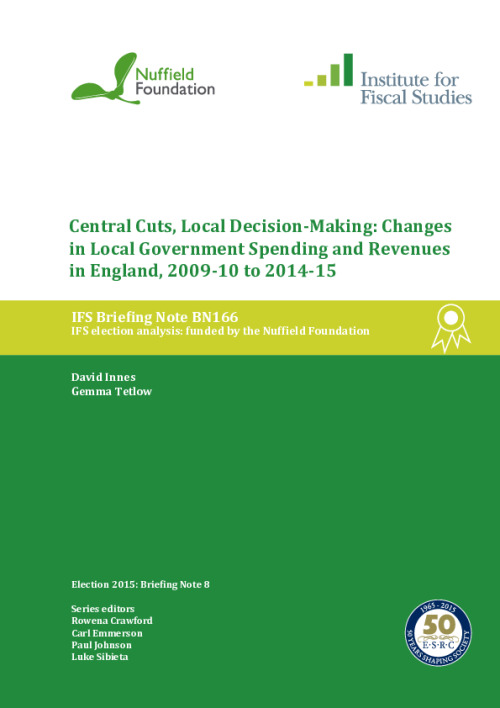This briefing note uses data from the Department for Communities and Local Government (DCLG) to delve into a number of questions about how local governments in England have responded to the reductions in their revenues. They have been forced to cut back significantly on service spending, but not all local authorities have been affected equally or reacted in the same way.
- The note focuses on net spending by local authorities on public services. We exclude spending on police and fire and rescue as this is not directly under the control of single-tier and county councils. We also exclude spending on education, public health and a small component of social care as local authorities’ responsibilities for these areas have been changing over time. During this parliament, this measure of spending by local authorities in England has been cut significantly in real terms. Between 2009–10 and 2014–15, it was cut by 20.4% after accounting for economy-wide inflation. Taking into account population growth over this period, spending per person was cut by 23.4%.
- These cuts to local authority spending were similar in magnitude to those seen on average across central government departments outside protected areas such as the NHS, schools and official development assistance.
- Local authorities have had to cut spending in the face of falls in their main sources of revenue. Grants from central government to local government (excluding housing benefit grant and those specifically for education, public health, police, and fire and rescue services and the housing benefit grant) have been cut by 36.3% overall (and by 38.7% per person) in real terms between 2009–10 and 2014–15. Total council tax revenues have grown slightly in real terms over this period (3.2%), although this still represents a decline of 0.7% per person. Taking grants and council tax revenues together, local authorities’ total revenues have fallen by 19.9% overall (or 22.9% per person) in real terms. Council tax revenues funded just over half of local government spending in 2014–15, up from 41% in 2009–10.
- Even though revenues have fallen significantly, on average local authorities have spent less than they received from grants and council tax over the last five years, meaning that on average they have increased their reserves rather than drawn from them. The average increase in reserves across local authorities in England was an increase equal to 5% of annual spending in 2009–10.
The size of cuts has varied across the country
- While the average cut to local authority net service spending per person (excluding education, public health, police, and fire and rescue) was 23.4%, the change seen by individual local authorities ranged from a maximum reduction of 46.3% per person (in Westminster) to a reduction of 6.2% per person (in North East Lincolnshire).
- Cuts to net service spending have tended to be larger in those areas that were initially more reliant on central government grants (as opposed to locally-raised revenues) to fund spending – these are areas that have, historically, been deemed to have a high level of spending need relative to their local revenue-raising capacity. The cuts to spending per person were also higher on average in areas that saw faster population growth.
- As a result, London boroughs, the North East and the North West have seen the largest average cuts to spending per person. Since these regions initially had the highest level of spending per person, there has been some equalisation in the average level of local authority spending per person across regions over the last five years. In 2009–10, spending per person was on average 80.1% higher in London than in the South East; by 2014–15 – with London having seen spending cuts that were nearly twice as deep as those seen in the South East – this differential had fallen to 48.0%.
- Since central government grants were cut much more deeply than council tax revenues, it is perhaps not surprising that those authorities for which grants made up a larger share of income saw larger cuts to their overall spending power. However, up to 2013–14 at least, the mechanism for allocating government grants was intended to take account of differences in local need and local revenue-raising capacity. But we can find no evidence that the formula actually operated in this way between 2009–10 and 2013–14. Indeed, there seems to have been no greater protection of more needy areas over this period than there was in 2014–15 when the new system for allocating grants – which explicitly does not account for changing relative needs – was introduced.
Some services have been cut more than others
- Social care was the single largest component (comprising 47.2%) of local service spending in 2009–10 (excluding education, police and fire services). It is also one of the areas that have experienced smaller-than-average cuts in spending per person over this parliament. Between 2009–10 and 2014–15, net spending per capita on social care was cut by 16.7%.
- Some of the service areas that saw the largest cuts to net spending were planning and development (which was cut to less than half its original level), regulation and safety, housing, and transport (all of which were cut by at least 30%). Net local authority spending on transport was cut by 45% in London, and by between a quarter and a third in other areas of the country, although transport providers offset some of this cut by raising fares.
- There was variation across the country, however, in which services different local authorities chose to focus the cuts on. The vast majority of local authorities chose to cut social care spending by less than other service areas. But prioritisation of other service areas has varied: for example, most areas have cut housing spending heavily but a minority of areas (particularly in London) have actually afforded it relative protection.
Planned cuts for 2015–16
- Local authorities are expected to face further cuts to revenues per person of 4.1% in 2015–16 (excluding specific grants for mandatory housing benefit payments and education, public health, fire and police services), meaning that the cumulative cut to revenues per person since 2009–10 will be 26.1%. This assumes that all councils freeze council tax rates (and accept the ‘freeze grant’ from central government) next year.
- The local authorities that have seen the largest cuts to revenues per person since 2009–10 are also those expected to see the largest cuts in 2015–16. London boroughs face a cut to revenues per person of 6.3%, which compares with 1.9% for shire counties.
- Local authorities differ in their ability to offset the cuts to their grants by increasing council tax revenues, because a given increase in council tax rates would increase overall revenues by less for councils that are more grant-reliant. For example, a 2% increase in council tax rates would, on average, increase revenues per person by 0.3% for London boroughs, compared with 0.5% for shire counties. This may explain why London boroughs have been the most likely, over recent years, to accept the council tax freeze grants, while unitary authorities have been the least likely to do so.
Future pressures
- There are likely to be further cuts to public service spending, and therefore local authority spending, over the next parliament. Future cuts may well be focused on the same local authorities that have experienced the largest cuts over this parliament.
- The new system for allocating central government grants essentially applies a uniform cut to all authorities’ grants, meaning that those with less local revenue-raising capacity will see larger cuts to their total spending power. These areas have also, on average, seen the largest cuts to spending power over this parliament.
- The new system also will not account for differences in population growth across areas. This means that those areas that see the fastest population growth will (other things equal) see the sharpest falls in grants per head. Official population projections suggest that the eight local authorities expected to have the fastest population growth over the next five years are all London boroughs, which also saw the fastest growth over the last five years.
- Social care spending is already the single largest activity undertaken by local authorities, comprising more than half (53.1%) of total local authority spending (excluding education, public health, police and fire services) in 2014–15, and it has been relatively protected from cuts over this parliament. However, pressures on this area of service provision are likely to continue to grow over the next parliament, as the Office for National Statistics (ONS) projects that the population aged 75 and over will grow by 13.9%, much faster than overall population growth.
- A future government could choose to increase spending on local government, although – since all three main UK parties are committed to reducing borrowing over the next parliament – this would likely have to come at the cost of reducing spending (or raising taxes) elsewhere.
- Another option for easing the pressure on some local authorities would be to increase the cap on council tax rises before a local referendum is required (which is set at 2% for 2015–16) and/or change the mechanism for allocating central government grants to distribute these in a way that implies more equal cuts to local authorities’ total revenues.










